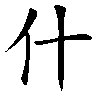什
See also: 甚
| ||||||||
Translingual
| Stroke order | |||
|---|---|---|---|
| Stroke order | |||
|---|---|---|---|
 | |||
Han character
什 (radical 9, 人+2, 4 strokes, cangjie input 人十 (OJ), four-corner 24200, composition ⿰亻十)
References
- KangXi: page 91, character 6
- Dai Kanwa Jiten: character 348
- Dae Jaweon: page 192, character 6
- Hanyu Da Zidian: volume 1, page 108, character 2
- Unihan data for U+4EC0
Chinese
Glyph origin
| Historical forms of the character 什 | |||
|---|---|---|---|
| Warring States | Shuowen Jiezi (compiled in Han) | ||
| Qin slip script | Small seal script | ||
 |
 | ||
| |||
|
References: Mostly from Richard Sears' Chinese Etymology site (authorisation),
| |||
| Characters in the same phonetic series (十) (Zhengzhang, 2003) | |
|---|---|
| Old Chinese | |
| 針 | *kjum, *kjums |
| 汁 | *kjub |
| 卙 | *kʰljub |
| 十 | *ɡjub |
| 什 | *ɡjub |
Compounds
Definitions
什
Compounds
Japanese
Kanji
什
- This term needs a translation to English. Please help out and add a translation, then remove the text
{{rfdef}}.
Readings
- Go-on: じゅう (jū)←じふ (zifu, historical)
- Kan-on: しゅう (shū)←しふ (sifu, historical)
- Kun: くみ (kumi, 什); とお (tō, 什)←とを (towo, historical); まじる (majiru, 什じる)
Korean
Vietnamese
Han character
- This term needs a translation to English. Please help out and add a translation, then remove the text
{{rfdef}}.
References
This article is issued from
Wiktionary.
The text is licensed under Creative
Commons - Attribution - Sharealike.
Additional terms may apply for the media files.

